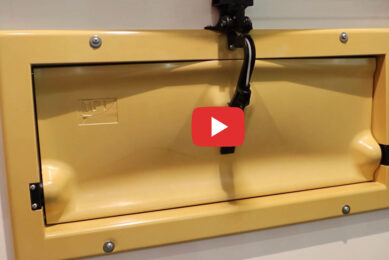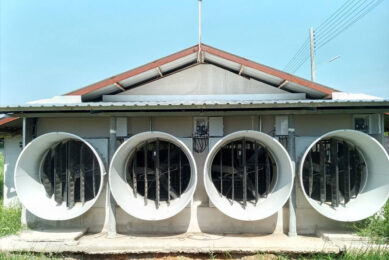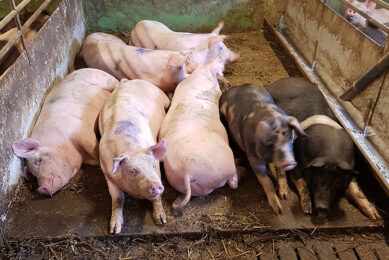Airbags in piggery ventilation (I)

An important one – and an underused one. Pig buildings are getting bigger with much more space to ventilate, and correct air distribution is more difficult in these widespan buildings. Many now house dry sows in large groups in Electronic Sow Feeding (ESF) layouts when the atmosphere can become oppressive in hot weather, causing abnormal behaviour such as aggression, vulva biting, disturbances at the feeders, bed fouling, and less relaxed resting.
Also, in all group sizes of growing pigs the air can become polluted in cold weather due to insufficient air movement as the environment is closed up to conserve heat and cope with freezing outside wind pressure on the inlet/ outlet fans. This stuffy atmosphere encourages tail biting and risks the pigs exceeding their ECT (Evaporative Critical Temperature) where food nutrients are diverted from growth due to rising stress levels and inappetance.
The airbag concept, sometimes called trunked ventilation, helps in both situations at minimum cost. It consists of a simple inlet fan at one gable end of the building, blowing a continual stream of air first through an air straightener, and then on to inflate a polypropylene tube where, through holes cut in the side, the air is directed on to the pigs.
Figure 1
Advantages
- It is cheap – the cheapest of any forced-ventilation system. When used in a nursery as an alternative to conventional systems, cost has been reduced by 22% even allowing for the fan(s) to be running continuously. In 2012, capital costs have varied from €1.02/ m to €3.30/ m depending on size. In a gestation barn converted from a stall layout to a free-access group system – instead of several high capacity fans, two airbag ducts have halved the cost;
- It is flexible as the air exit can be altered and placed accurately to remove ‘deadspots’ in seconds and so provide positive air movement in buildings that are otherwise difficult to ventilate. They also prevent hot air from radiant heaters from collecting near the roof;
- The ‘throw’ is usually sufficient to remove stuffiness from any area in a widespan building, so is particularly valuable as a hot weather back-up in large dry sow group housing;
- Airbag DIY is not only feasible but simple – not a difficult construction job, as 85% of what is needed can be made on the farm – only the inlet fan needs to be purchased. All that is required is some 500 gauge sheeting, a pair of scissors, lengths of 600 x 150 mm wooden battens, some wire or twine to suspend the tube from the ceiling, plus some sheet metal to weld into an air straightener so as to counteract the torque from the inlet fan as the air enters the tube. Without this simple device the tube will twist, making it impossible to direct the incoming air properly. Full construction details will be described next month;
- Ducts made of polythene film are lightweight and so impose a negligible load on the roof. Being indoors away from outside ultraviolet light, they do not degrade;
- The system is adaptable. There is a wide choice of where the ducts can be hung and the number and size of exit holes. Some of my clients have ‘summer’ and ‘winter’ ducts with different air placement. Changing over takes around 30 minutes.
But does it work?
Yes it does. I first picked up the idea from two British pioneer ventilation engineers in the 1970s, named Jeff Owen (Reading University) and George Carpenter (Institute of Agricultural Engineers). There are two versions, the ‘straight-through’ concept and the ‘recirculation’ system which the UK Farmex company later refined; recirculation ventilation being mainly used in smaller barns largely to conserve heat in winter.
I have found the simpler and cheaper straight-through system to be particularly useful in dry sow wide-spans (stalls or groups) in summer when it cuts in as the temperature over the animals passes 26°C. On one farm vulva -biting ceased immediately and on two others quarrelling at the feed stations was reduced. On two strawed units sows were fouling their sleeping areas and this was stopped once an airbag was positioned over them.
Next month I shall describe the important measurements you need to follow to get the system working perfectly. Fortunately you can easily make nearly all of this yourselves!
[Source: Pig Progress magazine Vol 30 nr 1, 2014 – ‘What the textbooks don’t tell you about…’ series]











